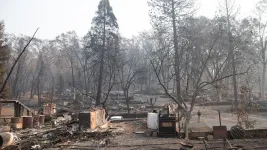(Press-News.org) In 2018, the Camp Fire ripped through the town of Paradise, California at an unprecedented rate. Officials had prepared an evacuation plan that required 3 hours to get residents to safety. The fire, bigger and faster than ever before, spread to the community in only 90 minutes.
As climate change intensifies, wildfires in the West are behaving in ways that were unimaginable in the past--and the common disaster response approaches are woefully unprepared for this new reality. In a recent study, a team of researchers led by the University of Utah proposed a framework for simulating dire scenarios, which the authors define as scenarios where there is less time to evacuate an area than is required. The paper, published on April 21, 2021 in the journal Natural Hazards Review, found that minimizing losses during dire scenarios involves elements that are not represented in current simulation models, among them improvisation and altruism.
"The world is dealing with situations that exceed our worst case scenarios," said lead author Thomas Cova, professor of geography at the U. "Basically we're calling for planning for the unprecedented, which is a tough thing to do."
Most emergency officials in fire-prone regions develop evacuation plans based on the assumptions that wildfires and residents will behave predictably based on past events. However, recent devastating wildfires in Oregon, California and other western states have shown that those assumptions may no longer hold.
"Wildfires are really becoming more unpredictable due to climate change. And from a psychological perspective, we have people in the same area being evacuated multiple times in the past 10 years. So, when evacuation orders come, people think, 'Well, nothing happened the last few times. I'm staying,'" said Frank Drews, professor of psychology at the U and co-author of the study. "Given the reality of climate change, it's important to critically assess where we are and say, 'Maybe we can't count on certain assumptions like we did in the past.'"
How to predict the unprecedented
The framework allows planners to create a dire wildfire scenario--when the lead time, defined as the time before the fire reaches a community to respond, is less than the time required to evacuate. The authors developed a scoring system that categorizes each scenario as routine, dire, very dire or extremely dire based on many different factors.
One big factor affecting the direness is the ignition location, as one closer to a community offers less time than one farther away. A second major factor is the wildfire detection time. During the day, plumes of smoke can cue a quick response, but if it starts at night when everyone is asleep, it could take longer to get people moving. Officials may delay their decisions to avoid disrupting the community unnecessarily, but a last-minute evacuation order can cause traffic jams or put a strain on low-mobility households.
Alert system technologies can create dire circumstances if residents do not receive the warning in time due to poor cellphone coverage or low subscription rates to reverse 911 warning systems. If the community has many near misses with wildfire, the public's response could be to enact a wait-and-see approach before they leave their homes.
Using a dire scenario dashboard, the user assigns various factors an impediment level--low, minor or major--that can change at any point to lessen or increase a situation's direness.
"Usually when we run computer simulations, nothing ever goes wrong. But in the real world, things can get much worse half-way through an evacuation," said Cova. "So, what happens when you don't have enough time? The objective switches from getting everyone out to instead minimizing casualties. It's dark."
"More people began working remotely from home during the pandemic, which then led to them moving out of large cities into rural areas," explained assistant professor Dapeng Li of the South Dakota State University Department of Geography and Geospatial Sciences, a co-author and U alumnus who helped develop the computer simulations. "These rural communities typically have fewer resources and face challenges in rapidly evacuating a larger number of residents in this type of emergency situation."
Reducing dire scenarios
Simulating dire wildfire scenarios can improve planning and the outcomes in cases where everything goes wrong. For example, creating fire shelters and safety zones inside of a community can protect residents who can't get out, while reducing traffic congestion for others who can evacuate. During the 2018 Camp Fire, people improvised temporary refuges in parking lots and community buildings. Modeling could help city planners construct permanent safety areas ahead of time.
A common human response during wildfires are improvisations and creative thinking, which are difficult to model but can be literally lifesaving. For example, during the 2020 Creek Fire in California, a nearby military base sent a helicopter to rescue trapped campers. Another crucial component is individuals helping others, such as people giving others rides or warning neighbors who missed the official alert. During the Camp Fire, Joe Kennedy used his bulldozer to singlehandedly clear abandoned cars that were blocking traffic.
"It is very common for families and neighbors to assume a first responder role and help each other during disasters," said Laura Siebeneck, associate professor of emergency management and disaster science at the University of North Texas and co-author of the study. "Many times, individuals and groups come together, cooperate, and improvise solutions as needed. Though it is difficult to capture improvisation and altruism in the modeling environment, better understanding human behavior during dire events can potentially lead to better protective actions and preparedness to dire wildfire events."
Studying and modeling dire scenarios is necessary to improve the outcomes of unprecedented changes in fire occurrence and behavior. This study is the first attempt to develop a simulation framework for these scenarios, and more research is needed to incorporate the unpredictable elements that create increasingly catastrophic wildfires.
INFORMATION:
Mosquitoes are one of humanity's greatest nemeses, estimated to spread infections to nearly 700 million people per year and cause more than one million deaths.
UC Santa Barbara Distinguished Professor Craig Montell has made a breakthrough in one technique for controlling populations of Aedes aegypti, a mosquito that transmits dengue, yellow fever, Zika and other viruses. The study, published in the Proceedings of the National Academy of Sciences, documents the first use of CRISPER/Cas9 gene editing to target a specific gene tied to fertility in male mosquitoes. The researchers were then able to discern how this mutation can suppress ...
A study conducted by researchers at the U.S. Department of Energy's (DOE) Argonne National Laboratory reveals that the use of corn ethanol is reducing the carbon footprint and diminishing greenhouse gases.
The study, recently published in Biofuels, Bioproducts and Biorefining, analyzes corn ethanol production in the United States from 2005 to 2019, when production more than quadrupled. Scientists assessed corn ethanol's greenhouse gas (GHG) emission intensity (sometimes known as carbon intensity, or CI) during that period and found a 23% reduction in CI.
According ...
MUSC Hollings Cancer Center researchers are exploring the use of peptide carriers for the delivery of small RNA drugs as a novel treatment for cancer. The team's recent work, published online March 19 in the Molecular Therapy - Nucleic Acids journal, lays the foundation for developing a clinically relevant peptide carrier RNAi-based drug treatment strategy for human oral cancer.
According to the American Cancer Society, the estimated risk of developing oral cancer in the U.S. is 1 in 60 for men and 1 in 140 for women. Cancer therapies face multiple challenges, including off-target side effects and low efficacy. ...
MAY 24, 2021, NEW YORK - A Ludwig Cancer Research study has discovered how to revive a powerful but functionally inert subset of anti-cancer immune cells that are often found within tumors for cancer therapy.
Led by Ludwig Lausanne's Ping-Chih Ho and Li Tang of the École Polytechnique Fédérale de Lausanne, the study describes how an immune factor known as interleukin-10 orchestrates the functional revival of "terminally exhausted" tumor-infiltrating T lymphocytes (TILs), which have so far proved impervious to stimulation by immunotherapies. It also demonstrates that the factor, when applied in combination with cell therapies, can eliminate tumors in mouse models of melanoma and colon cancer. The findings are reported in the current issue of Nature ...
MIAMI - Scientists from the University of Miami (UM) Rosenstiel School of Marine and Atmospheric Science analyzed ground movements measured by Interferometric Synthetic Aperture Radar (InSAR) satellite data and GPS stations to precisely model where magma intruded and how magma influx changed over time, as well as where faults under the flanks moved without generating significant earthquakes. The GPS network is operated by the U.S. Geological Survey's Hawaii Volcano Observatory.
"An earthquake of magnitude-6 or greater would relieve the stress imparted by the influx of magma along ...
BOSTON - Cardiovascular disease (CVD) is the leading cause of death in the United States. Public health advocates frequently site Americans' high-sodium diet as one factor in the nation's cardiac health. While sodium has been definitively linked to high-blood pressure -- a key risk factor for CVD -- few rigorously controlled studies make the direct causal link between high sodium intake and cardiovascular damage, heart attack, or stroke.
In a new analysis, researchers from Beth Israel Deaconess Medical Center (BIDMC) examined three cardiovascular biomarkers, which are measurable indicators ...
California state school nutrition policies and federal policies for school meals have mixed impacts on childhood obesity in children of Pacific Islander (PI), Filipino (FI) and American Indian/Alaska native (AIAN) origins, according to a new study published this week in the open access journal PLOS Medicine by Mika Matsuzaki of Johns Hopkins Bloomberg School of Public Health, USA, and colleagues.
Children of PI, FI and AIAN origin are some of the most understudied subgroups experiencing high rates of overweight/obesity. California has enacted policies on foods and beverages available in schools through a series of standards ...
People don't gain or lose weight because they live near a fast-food restaurant or supermarket, according to a new study led by the University of Washington. And, living in a more "walkable", dense neighborhood likely only has a small impact on weight.
These "built-environment" amenities have been seen in past research as essential contributors to losing weight or tending toward obesity. The idea appears obvious: If you live next to a fast-food restaurant, you'll eat there more and thus gain weight. Or, if you have a supermarket nearby, you'll shop there, eat healthier and thus lose weight. Live in a neighborhood that makes walking and biking easier and you'll get out, exercise more and burn more calories. ...
Researchers at the Karolinska Institutet, University of Oxford and University of Copenhagen have shown that elevated levels of lipids known as ceramides can be associated with a ten-fold higher risk of death from cardiovascular disease. Treatment with liraglutide could keep the ceramide levels in check, compared with placebo. The results have been published in the Journal of the American College of Cardiology.
Approximately 16 percent of the Swedish population suffers from obesity (BMI over 30), which is one of the greatest risk factors for cardiovascular diseases such as myocardial infarction and stroke. The World Health ...
Has your heart ever started to race at the thought of an upcoming deadline for work? Or has the sight of an unknown object in a dark room made you jump? Well, you can probably thank your amygdala for that.
The small almond-shaped brain structure is central to how we perceive and process fear. As we start to learn to associate fear with cues in our environment, neuronal connections within the amygdala are dynamically altered in a process called synaptic plasticity. Although this physiological mechanism is important for facilitating fear learning, it has mostly been studied in the context of excitatory neurons within the amygdala. Far less is known about the role inhibitory cells ...





